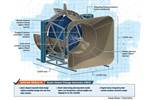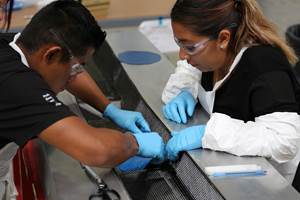Carbon fiber satellite arm reduces weight, simplifies assembly onto naval vessels
Satcom developer EM Solutions partnered with ACS Australia to replace an aluminum arm design with a 65% lighter, one-piece, corrosion-resistant carbon fiber/epoxy alternative.
Satcom systems developer EM Solutions sought a lighter, simpler-to-install design for the identical azimuth arms on its King Cobra naval-mounted satellite. Partner ACS Australia provided a design and manufacturing solution that resulted in a 65% lighter arm versus metal, reducing dozens of pieces to one per arm. Source | EM Solutions, via ACS Australia
Satellite communication (satcom) systems can be complex, carefully designed to access and communicate with satellites in various orbits and consisting of — at their most basic — a dish-like antenna reflector assembly mounted to a rotating arm. This arm is a critical structural element, which needs to be strong enough to support the antenna load, provide attachment areas for all of the electronics, and enable 360-degree rotation with precision.
For satcom systems mounted atop naval vessels, in particular, there are a range of additional requirements needed, such as light weight to enable the vessel to carry more payload, ease of installation and defense specifications like extreme durability and high blast tolerance.
In 2021, satcom technology developer EM Solutions (Brisbane, Queensland, Australia) began designing a new satcom system, called the King Cobra, intended to mount on naval vessels. The King Cobra is a 2-meter-diameter satcom terminal, designed to transmit and receive signals for both military and commercial bands, to and from geosynchronous equatorial orbit (GEO), medium-Earth orbit (MEO), highly elliptical orbit (HEO) and low-Earth orbit (LEO) satellite constellations.
Typically, the two identical arms for this type of satcom system — sometimes referred to as azimuth arms — would be made from machined aluminum, composed of up to dozens of small components joined with metallic fasteners. While standard, this type of arm can be relatively heavy for a small naval vessel, complex to install because of the high number of components and prone to corrosion from regular contact with water in this type of application.
Each 2-meter arm was designed to fit onto the existing satcom system with as few changes as possible to the original end fittings. Source | ACS Australia
EM Solutions decided to seek out design and manufacturing solutions for the King Cobra’s arms that would decrease the part complexity and weight of the overall satcom system.
For this, the company ultimately partnered with Advanced Composite Structures Australia (ACS Australia, Port Melbourne), a composites technology solutions company with experience in design, prototyping, manufacturing and assembly, and testing of composite parts in a wide range of industries.
With ACS Australia involved, the goal was to develop an all carbon fiber/epoxy composite arm, with a simplified, easy-to-install design that saved weight compared to an aluminum alternative. The arm also needed to be designed to fit the existing system and assembly process without any major adjustments to the adjusting end fittings.
The resulting arm design is a single-piece arm, measuring approximately 1.5 × 0.5 × 0.5 meters in size, constructed from plies of carbon fiber fabric cut via CNC machining and infused under vacuum with liquid epoxy. ACS Australia both designed the parts and manufactures them at their facility.

ACS Australia uses finite element modeling and physical testing to ensure the arm design passed needed load and blast requirements for defense applications. Source | ACS Australia
According to ACS Australia, one of the biggest challenges in redesigning the part in composites was ensuring the same high-quality finish, a challenge that was perfected over several iterations.
Among its improvements versus the metallic alternative, the composite version is reported to be 65% lighter weight with approximately 50 fewer components (thus requiring significantly fewer fasteners and fittings). The composite version is also corrosion-resistant, durable, takes less time to assemble and has fewer expected maintenance needs and costs over its lifetime.
This design also helps reduce topside weight for navy vessels, and reduces power consumption and sizing requirements for subsystems due to lightweight composite construction.
Clayton Somers, senior composites technician at ACS Australia, says that the weight savings have resulted in a part that “is now possible for one person to handle, to pick up the arm.”
The arm design won a Composites Australia Innovation Award for the ACS-A team. Source | ACS Australia
The design ultimately met static and dynamic requirements, including the high blast requirements of topside naval structures. The arm was first validated by ACS Australia engineers via finite element analysis at various load conditions.
Beginning in late 2023, “The arms are now successfully integrated into the King Cobra satcom product and are now operating in service,” on navy vessels in Australia and Europe, Somers says. The design won EM Solutions and ACS Australia a Composites Australia Innovation Award for Advancements in Composites Technology in 2024.
Related Content
Co-molding SMC with braided glass fiber demonstrates truck bed potential
Prepreg co-molding compound by IDI Composites International and A&P Technology enables new geometries and levels of strength and resiliency for automotive, mobility.
Read MoreMFFD longitudinal seams welded, world's largest CFRTP fuselage successfully completed
Fraunhofer IFAM and partners have completed left and right welds connecting the upper and lower fuselage halves and sent the 8×4-meter full-scale section to ZAL for integration with a cabin crown module and testing.
Read MoreCombining multifunctional thermoplastic composites, additive manufacturing for next-gen airframe structures
The DOMMINIO project combines AFP with 3D printed gyroid cores, embedded SHM sensors and smart materials for induction-driven disassembly of parts at end of life.
Read MoreComposites manufacturing for general aviation aircraft
General aviation, certified and experimental, has increasingly embraced composites over the decades, a path further driven by leveraged innovation in materials and processes and the evolving AAM market.
Read MoreRead Next
ACS-A to develop composite prototypes, processes for MoorPower wave energy project
The two-year, Australia-based demonstrator project aims to use wave energy conversion technology to decarbonize offshore aquaculture operations.
Read MoreHydroelectric turbine blade design propelled by composites
Glass fiber composites power the development of a modular, spiral-shaped hydroelectric micro turbine blade for low-cost, high-efficiency renewable energy generation.
Read MoreAssembling the Multifunctional Fuselage Demonstrator: The final welds
Building the all-thermoplastic composite fuselage demonstrator comes to an end with continuous ultrasonic welding of the RH longitudinal fuselage joint and resistance welding for coupling of the fuselage frames across the upper and lower halves.
Read More
.jpg;width=70;height=70;mode=crop)
























